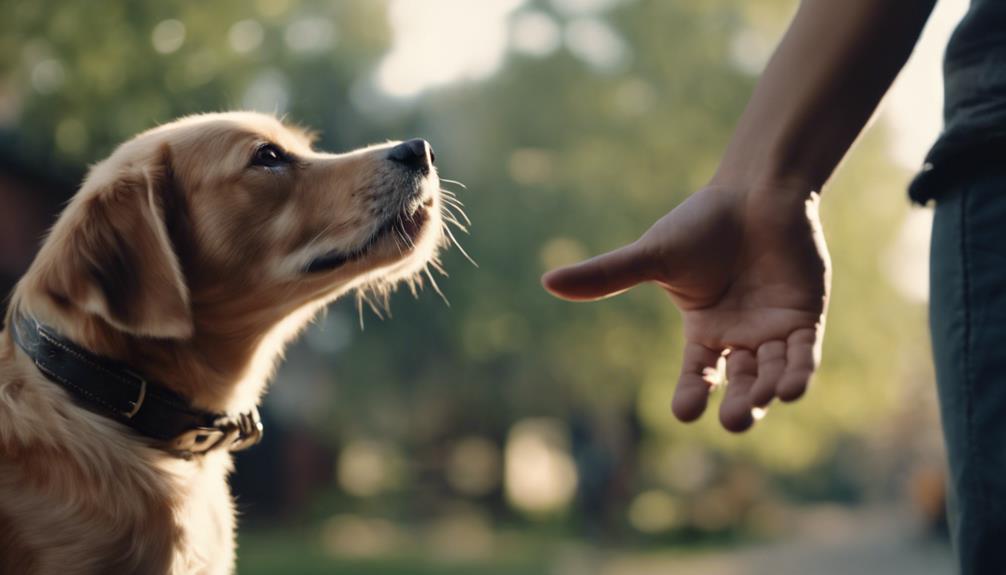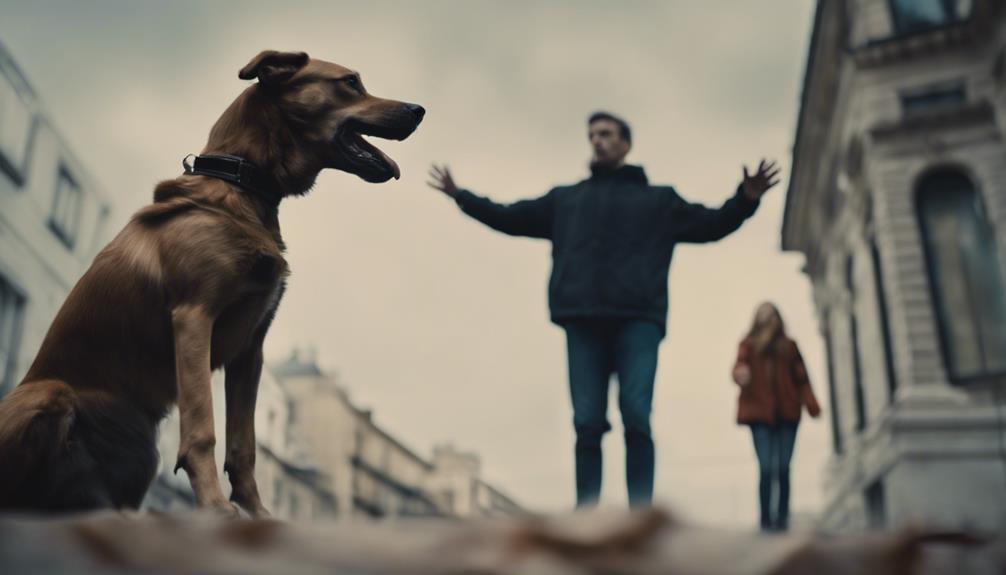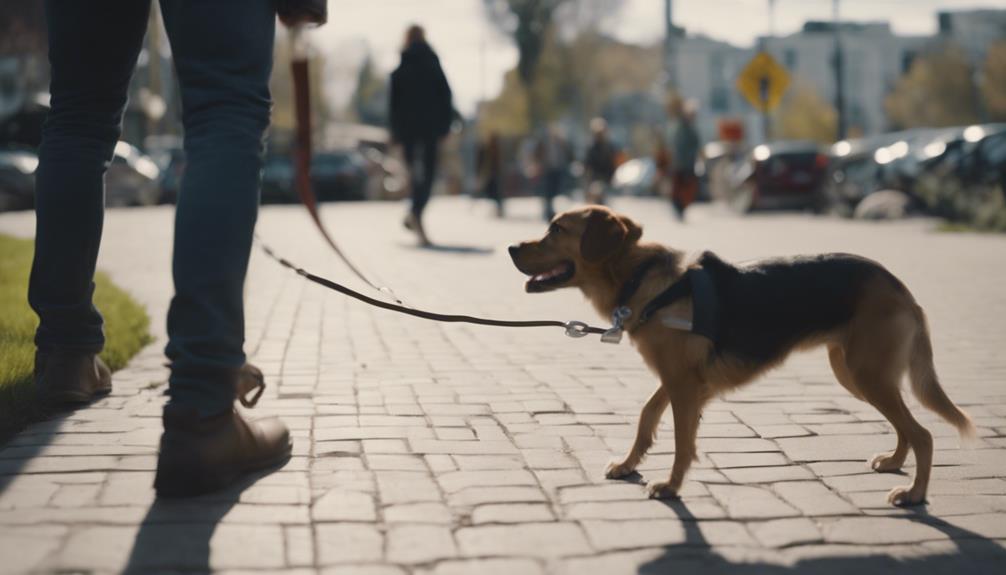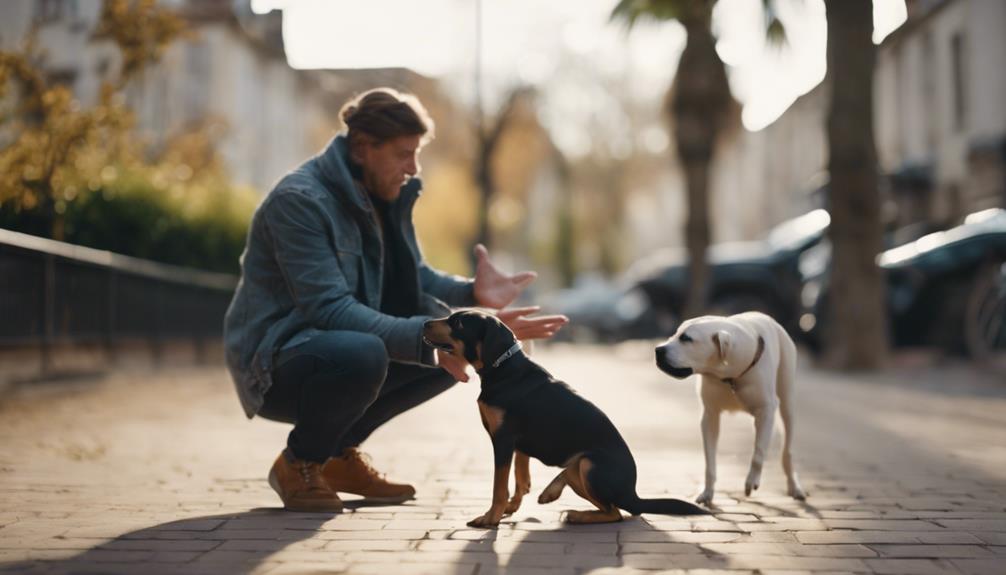Imagine you're navigating through a labyrinth of uncertainty, trying to grasp the elusive threads that will lead you to a scared or lost dog in need. With each step, your actions can either draw them closer to safety or push them further into distress.
As you venture into the intricate world of canine rescue, understanding the delicate balance between the do's and don'ts of catching these vulnerable animals becomes paramount.
Stay tuned to uncover the vital strategies that could make all the difference in your mission to offer help and comfort to these lost souls.
Key Takeaways
- Approach lost or scared dogs calmly to avoid triggering survival instincts.
- Do not chase or corner the dog; it may worsen fear and aggression.
- Contact animal control or a professional for help in catching a scared stray dog.
- Ensure the safety of yourself and the dog by using proper techniques and resources.
Recognizing Survival Mode Behaviors
Recognizing survival mode behaviors in a lost or scared dog is crucial for effectively approaching and helping the distressed animal. When a dog is in survival mode, it may exhibit behaviors such as fleeing from humans, showing signs of aggression, freezing in place, or displaying excessive anxiety. These behaviors are the dog's way of coping with fear and stress.
Dos of Catching a Scared Dog
When attempting to catch a scared dog, approach slowly and calmly to avoid further distressing the animal. It's important to remember that a scared dog may react unpredictably, so your approach should be gentle and non-threatening. Here are some dos of catching a scared dog:
| Dos | Explanation |
|---|---|
| Move Slowly | Sudden movements can startle the dog further. |
| Use Soft, Soothing Voice | Talking in a calm, reassuring tone can help to ease the dog's anxiety. |
| Offer Treats Strategically | Using treats can help in gaining the dog's trust and cooperation. |
| Provide Safe Enclosure | Once caught, place the dog in a secure area to prevent escape. |
Don'ts of Catching a Scared Dog

When catching a scared dog, refrain from making sudden movements that can escalate the animal's fear and potentially lead to a dangerous situation. Sudden gestures may startle the dog, causing it to react defensively.
Avoid direct eye contact, as this can be perceived as a threat by a frightened dog. Additionally, shouting or speaking loudly might further agitate the animal.
Never chase a scared dog as this can trigger its flight response, making it run into traffic or unfamiliar territory. Don't attempt to corner the dog, as this can intensify its fear and result in aggressive behavior.
Patience and calm movements are key when handling a scared dog to ensure the safety of both you and the animal.
Dos of Approaching a Lost Dog
To approach a lost dog safely, maintain a calm demeanor and move slowly to avoid startling the animal. Speak softly to reassure the dog that you aren't a threat. Avoid direct eye contact, as this can be perceived as a challenge. Get down to the dog's level to appear less intimidating.
Allow the dog to approach you first, rather than advancing too quickly. Use treats or a gentle tone to encourage the dog to come closer. Pay attention to the dog's body language for signs of fear or aggression. Slow movements and a peaceful vibe will help build trust between you and the lost dog, increasing the chances of a successful interaction.
Don'ts of Approaching a Lost Dog

When approaching a lost dog, remember to refrain from making sudden movements or loud noises, as these actions can escalate fear and anxiety in the animal.
Avoid direct eye contact, as dogs may interpret it as a threat. Don't try to chase the dog or corner it, as this can lead to defensive behaviors.
It's important not to reach out your hand for the dog to smell immediately, as they may view it as invasive. Avoid bending over the dog or looming over it, as this can be intimidating.
Lastly, don't assume that all lost dogs are friendly; proceed with caution and be prepared for any unpredictable reactions.
Ensuring Safety When Catching a Stray
Ensuring safety when catching a stray dog involves taking necessary precautions to protect both yourself and the animal. It's crucial to approach the situation with care and consideration for the well-being of the dog. Here are some key safety measures to keep in mind:
| Safety Measure | Description |
|---|---|
| Approach with Caution | Move slowly and avoid sudden movements to prevent scaring the dog. |
| Use Protective Gear | Wear gloves and long sleeves to protect yourself from potential bites. |
| Avoid Direct Eye Contact | Dogs may see this as a threat, so keep your gaze soft and avert direct eye contact. |
Importance of Microchipping and ID

It's vital to prioritize the well-being of a stray dog by ensuring they've proper identification through microchipping and ID tags. Having identification on a lost or scared dog can make a significant difference in reuniting them with their owners.
- Microchipping provides a permanent form of identification that can't get lost or removed.
- ID tags with a current phone number can help a Good Samaritan contact you directly.
- Registering the microchip and updating the contact information is crucial for effectiveness.
- Collars with visible identification can help people easily recognize that the dog has an owner.
Safety Measures for Lost Dogs
Prioritize the safety of lost dogs by keeping them in a secure, open area where they can feel protected and comfortable. Use a leash to guide the dog to a safe location, offering water but avoiding feeding them. Ensure the area is fenced properly to prevent escape. Never leave the dog unattended outside.
Fit them with appropriate collars and leashes, and train them on recall commands. Avoid using retractable leashes for safety reasons. Supervise outdoor time to prevent accidents or escapes. By implementing these safety measures, you can help lost or scared dogs feel secure and prevent further distress.
Dog Behavior and Communication

Understanding how dogs communicate with each other is essential for building a strong bond with your furry companion. Dogs have various ways of expressing themselves to convey their feelings and needs effectively. Here are some key points to consider:
- Body Language: Pay attention to your dog's posture, tail wagging, and ear position.
- Vocalizations: Understand the different barks, whines, and growls your dog uses to communicate.
- Facial Expressions: Learn to interpret your dog's facial cues for a deeper understanding of their emotions.
- Scent Marking: Recognize that dogs use scent to communicate with other animals and mark their territory effectively.
Dog Safety and Training Tips
To ensure your dog's safety and well-being, follow these essential tips for training and handling your furry companion effectively.
When training your dog, consistency is key. Use positive reinforcement techniques such as treats and praise to encourage good behavior. Establish clear boundaries and rules to help your dog understand expectations. Socialize your dog with other animals and people to prevent aggression and fear. Ensure your dog gets regular exercise to maintain physical and mental health. Invest time in teaching basic commands like sit, stay, and come. Consider professional training classes if needed.
Always supervise interactions with new dogs and environments. By prioritizing training and safety measures, you can build a strong bond with your dog and ensure a happy, well-adjusted pet.
Conclusion
In conclusion, by understanding the do's and don'ts of catching a lost or scared dog, you can make a significant difference in their rescue and care.
Remember to approach with caution, respect their space, and prioritize safety at all times.
With the right knowledge and skills, you can provide these vulnerable animals with the help and support they need to find their way back home or receive proper care.
Keep up the good work in being a compassionate and responsible advocate for dogs in need.




